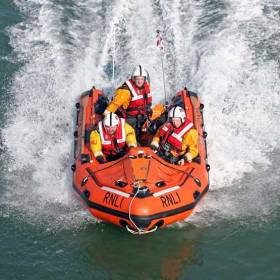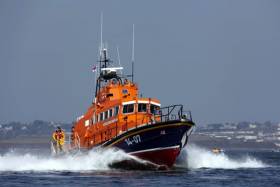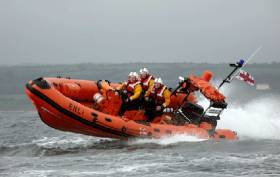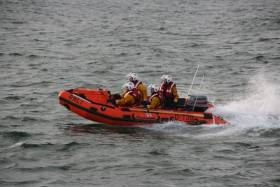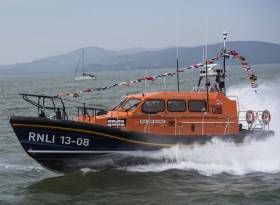Displaying items by tag: Lifeboats
Ballycotton Lifeboat Rescues Swimmer In Difficulty
#RNLI - Ballycotton RNLI was launched around 2.30pm yesterday afternoon (Tuesday 12 July) to aid a man who had got into difficulty while swimming in East Cork's Ballyandreen Bay and called for help.
A member of the public heard the man's call and immediately alerted Valentia Coast Guard, who tasked Ballycotton's volunteer crew to launch both their all-weather and inshore lifeboats.
The inshore lifeboat was first to arrive on scene and the crew on board recovered the casualty from the water before transferring him to the all-weather lifeboat, where he was medically assessed, administered first aid and given oxygen.
The Irish Coast Guard's Waterford-based helicopter Rescue 117 was also tasked and arrived on scene around 3pm to airlift the casualty to Cork University Hospital, where he is said to be in a stable condition.
Speaking following the callout, Ballycotton RNLI coxswain Eolan Walsh said: "We would like to commend the member of the public who raised the alarm today as well as the immediate first aid action of the volunteer crew.
"Their quick-thinking and actions ensured that there was a positive outcome today for this casualty. We would also like to wish him a speedy recovery."
#RNLI - A visiting yacht which ran aground on the way into Wexford Harbour was rescued by Wexford RNLI on Thursday afternoon (7 July) in what was the third callout for the volunteer crew this week.
The previous evening, the lifeboat launched at 8.15pm to reports of a walker on rocks near Wexford Bridge by members of Wexford Marinewatch who were concerned for their safety.
The lifeboat made its way to the wall which immerses in high tide and stood by until the individual was safely back on dry land.
On Tuesday (6 July) the lifeboat launched to reports of a possible sighting in the water, described as a white object that was splashing near Ferrycarrig Hotel. An extensive search of the area was carried out with nothing found.
Speaking after the week’s missions, Wexford RNLI volunteer lifeboat press officer Lorraine Galvin said: "All our volunteers are on call 24 hours a day, seven days a week and typically launch the lifeboat under 10 minutes of a 999 call.
"With at least two training exercises a week, the volunteers commit a great amount of time to providing rescue cover from Killurin Bridge to Curracloe Beach.
"We would also like to thank the fundraisers, who are all volunteers for their recent Flag Day collection and all those who donate to the RNLI to keep the service going allowing us to continue to saves lives at sea."
Local Community Raises Vital Funds For Larne RNLI
#RNLI - Over the last few months the generous people of Larne have raised over £2,000 for their local lifeboat station.
More than £600 was raised by the Great Northern Retro car rally that left Larne at 9am on Saturday 30 April, travelling up the scenic Antrim Coast to Malin Head. The event was very well supported with vehicles of all makes and models.
Meanwhile, local man John Stirling – father of lifeboat crew member Lee Stirling – celebrated his 60th birthday recently with a donation of £300 to the Larne lifeboat.
The Stirling family organised a surprise party and kindly asked for donations to Larne RNLI and the NI Air Ambulance in lieu of gifts.
Additionally, Larne Grammar School year 8 pupils, who are committed supporters of Larne RNLI, have again this year presented their local lifeboat station with a cheque for £1147.89 raised throughout the academic year.
"The people of Larne are very generous and dedicated supporters of our local lifeboat crew," said Jim Kerr, Larne RNLI fundraising chair, :I attended the start of the car rally and it was a fantastic spectacle to see the camper vans and cars leave Larne.
"I’d like to thank Gavin Gray who organised the NI Retros car rally, John Stirling for his birthday donation and the year 8 pupils of Larne grammar school for their kind donations.
"RNLI volunteer lifeboat crews around Ireland are willing to drop everything to go and save lives at sea when their pagers beep. We rely on the generosity of the public to continue our lifesaving service, which we operate day and night, 365 days a year.
"These donations can help fund crew training, contribute towards the running costs of a lifeboat station or buy new crew kit and are greatly appreciated by all at Larne RNLI."
#RNLI - Lough Derg RNLI's lifeboat launched this morning (Friday 1 July) to assist four people on board a 40ft cruiser whose anchor came loose and dragged beneath their boat in severe weather.
At 11.20am Valentia Coast Guard requested the lifeboat to attend to the cruiser located by Hare Island.
The lifeboat launched at 11.42am with helm Peter Clarke, Lorna Walsh and Barry Morkan on board. Winds were south-westerly Force 5, gusting 6/7, with good visibility.
The lifeboat was alongside the cruiser at 11.52am. Everyone on board was safe and unharmed and wearing their lifejackets.
An RNLI crew member reassured everyone on board the cruiser. Given the severe weather conditions and the exposed location, it was decided to let the anchor go when it could not be recovered back on board after numerous attempts.
The cruiser for any other potential problems, and everything was found to be in working order, so it continued its journey to the public harbour at Dromineer where it took shelter.
The lifeboat returned to station and was ready for service again at 1.14pm.
Lifeboat operations manager Liam Maloney advises boat users to "check the weather before setting out from harbour and ensure all items are stowed correctly".
Valentia Lifeboat Launches To Fishing Vessel Off Bolus Head
#RNLI - Valentia RNLI launched on Monday afternoon (27 June) to a 10m fishing vessel going aground off Bolus Head in Co Kerry after fouling its propeller.
The call for assistance came from Valentia Coast Guard at 3.44pm with Ballinskelligs inshore rescue and the Irish Coast Guard helicopter Rescue 115 also tasked to respond.
Ballinskelligs CRBI provided a tow to the vessel to remove it to safer water, where the Valentia lifeboat took over the tow for a short distance to free the obstruction from its propeller.
The skipper was then able to control the boat assistance and the tow was parted. The fishing vessel continued on without incident and Valentia RNLI returned to station.
#RNLI - Courtmacsherry RNLI's all-weather lifeboat was called out at 12.20pm yesterday afternoon (Monday 27 June) to aid a 40ft pleasure cruiser in difficulties just off the Seven Heads in West Cork.
The cruiser, with two people onboard, was on passage from East Ferry to Baltimore when it fouled its propellors about 300 yards off the cliffs at Seven Heads.
Its crew managed to hold themselves off the shore by tying the vessel to lobster pots until the lifeboat arrived. Conditions at sea were windy with a good swell.
The Courtmacsherry lifeboat, under coxswain Sean O'Farrell with crew of six, launched immediately and reached the stricken vessel at 12.45pm, succeeding in quickly getting a tow rope on board the casualty and assessing the damage before taking the vessel under tow to the safety of Courtmacsherry Pier
Naval Service vessel LE Orla also proceeded to the area and stood by with their divers if required.
This was the third similar callout and rescue in the past 10 days for the West Cork lifeboat station.
Crosshaven Lifeboat Helm Appointed To RNLI Council
#RNLI - Crosshaven RNLI has announced that Ian Venner, a helm with the crew, has been appointed to the RNLI Council for Ireland as one of its 15 members.
Venner has been a member of the lifeboat crew and a helm since the station was re-established in 2000.
An accountant by profession and a keen powerboater, Venner replaces on the council well-known Cork businessman and sailor Peter Crowley, who after 10 years on the council becomes an RNLI vice president.
The RNLI Council acts in the interest of the RNLI in the Republic and Northern Ireland and makes recommendations and gives advice to the RNLI Board, the Council and the Executive Team concerning lifeboat matters.
Union Hall Lifeboat Launches To Yacht Off Glandore Harbour
#RNLI - Union Hall RNLI was tasked by Valentia Coast Guard at 6.14pm on Monday (20 June 2016) to reports of a yacht in difficulty with a broken tiller three-and-a-half miles south of Glandore Harbour.
The volunteer lifeboat crew launched at 6.20pm and on arrival at the scene they escorted the yacht to Eve Island before establishing a tow and continuing on Union Hall pier, where the yacht was tied up at 7.17pm.
Union Hall RNLI deputy launching authority Jim Moloney said: "There was no immediate danger to the yacht or the crew but they were right to request assistance as soon as their tiller broke."
Portrush Lifeboat Launches To Swimmer In Difficulty
#RNLI - Portrush RNLI's inshore lifeboat launched yesterday evening (Tuesday 21 June) to reports of a swimmer in difficulty at the Herring Pond in Portstewart.
Three volunteer lifeboat crew launched the inshore lifeboat in cloudy conditions in a slight sea swell towards Portstewart, where they observed a young adult male not making progress in the sea.
The swimmer had got very tired and was spotted by an onlooker who raised the alarm.
Quickly arriving on scene, the lifeboat crew got the casualty on board and took him the short distance to Portstewart Harbour where they handed him into the care of the coastguard.
Portrush RNLI lifeboat operations manager Robin Cardwell said: "The onlooker did exactly the right thing. The RNLI would rather be called out if there is a danger of someone being in difficulty in the water. That’s what we are trained to do.
"The Respect The Water campaign highlights the dangers of the cold water and how quickly it is to get into difficulties."
#RNLI - Arklow man and former lifeboat operations manager Jimmy Tyrrell will have the honour of naming the first class of RNLI lifeboat to be named after an Irish river this Saturday 25 June in Buncrana, Co Donegal.
Lough Swilly RNLI will hold the special naming ceremony and service of dedication from 11.30am to officially name the first Shannon-class lifeboat in Ireland, Derek Bullivant.
The Donegal lifeboat station was the first in Ireland to receive the new €2.4 million lifeboat, which is the most modern and technically advanced lifeboat in the RNLI fleet.
Shortly after its arrival on station, the lifeboat brought three local fishermen to safety after they had been reported missing when their vessel had lost power and drifted out to sea.
The lifeboat was funded by legacies from Derek Bullivant and Valerie Walker. Bullivant was born in Birmingham in 1922 and was a trained chemist before working as an industrial analyst for a company in the metal industry. He went on to start his own company which became one of the biggest aluminium recycling companies in the UK. He always wanted his success to benefit lifesaving and humanitarian charities which led him to provide a generous legacy which helped to fund the Lough Swilly lifeboat.
The second legacy was bequeathed from Valerie Walker from Portsmouth. Walker was a supporter of the RNLI and her legacy has been used to part fund the lifeboat. Her generosity will be remembered and acknowledged by a plaque which will be placed in the boathouse at Lough Swilly lifeboat station.
The Shannon is first class of lifeboat to be propelled by water jets instead of traditional propellers, making it the most agile and manoeuvrable all-weather lifeboat in the fleet.
Waterjets allow the vessel to operate in shallow waters and be intentionally beached. The lifeboat has a top speed of 25 knots and a range of 250 nautical miles, which makes it ideal for offshore searches and rescues in calm and rough seas.
The new lifeboat was developed to operate in the worst of sea conditions and is self-righting, automatically turning the right side up in the event of a capsize. Its unique hull is designed to minimise slamming of the boat in heavy seas and the shock-absorbing seats further protect the crew from impact when powering through the waves.
Commenting on the forthcoming occasion, Lough Swilly RNLI lifeboat operations manager John McCarter said: "Many people will know that we welcomed the lifeboat to Buncrana a little over a year ago but in grand RNLI tradition we officially name and dedicate the lifeboat after that and in doing so remember our generous benefactors who through their legacies have provided this incredible gift to our community.
"We are delighted that Jimmy Tyrrell will be officially naming our lifeboat. Our colleagues in the lifeboat community will know that Jimmy lobbied the RNLI for years to have a class of lifeboat named in recognition of the role Ireland and Irish lifeboat volunteers have played in the work of the charity for 192 years. All other lifeboat classes are named after UK rivers so the Shannon is truly an Irish lifeboat."
The Shannon lifeboat also has another strong Irish connection. Peter Eyre, an RNLI engineer from Derry who works at the charity’s headquarters in Poole, was instrumental in the development of the new lifeboat, designing the hull form at the age of 24.
The first all-weather lifeboat put on service in Lough Swilly was The Good Shepard in 2000.






























